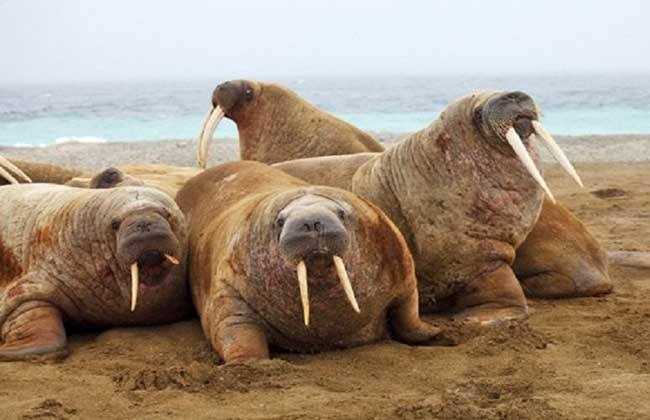Odobenus rosmarus
IUCN
LCBasic Information
Scientific classification
- name:Odobenus rosmarus
- Scientific Name:Walrus, Seahorse
- Outline:Carnivora
- Family:Carnivora Pinnipedia Odobenidae Odobenus
Vital signs
- length:Male 3.2 meters; female 2.7 meters
- Weight:Males 1200~1500 kg; Females 600~850 kg
- lifetime:30~40 year
Feature
It is the largest mammal in the ocean besides whales.
Distribution and Habitat
Walruses are found in the waters around the Arctic Circle, often living in shallow coastal waters and rarely appearing in deep seas (where they need to forage for food on gravel bottoms). They spend most of their time on coastal land or ice floes, where they reproduce, molt, and rest[2] (females usually spend more time).
Appearance
Walruses have huge bodies, thick and wrinkled skin, sparse bristles, small eyes, and poor vision. They have two long tusks. Unlike elephants on land, which have fat heads, big ears, long noses, and sturdy limbs, their limbs have degenerated into fins to adapt to life in the water. They cannot walk on land like elephants. They can only crawl on the ice by bending their hind flippers forward and piercing their tusks into the ice. Therefore, the scientific name of walruses, if translated into Chinese, means "walkers with tusks". Moreover, their noses are short and they lack ear shells, which makes them look very ugly.
Walruses are highly social animals and often live in large groups. Outside of the mating season, male and female walruses live in different groups.
When other male walruses break into their territory, fierce fights will occur, and they will attack each other with tusks and strong necks until the winner is decided, so males are often covered with scars.
Wal
Details
Walrus, as the name suggests, is the elephant in the sea. It has a huge body, thick and wrinkled skin, sparse bristles, small eyes, and poor eyesight. It has two long teeth.

Walrus is one of the largest representatives of the Arctic fauna. Among pinnipeds, they are second only to elephant seals in number. On average, an adult walrus weighs between 800 kg and 1.5 tons. Some can reach up to 2 tons. Males are 2.7-4.5 meters long, and females are 2.2-3.7 meters. The average weight of a newborn walrus is 25-30 kg, while Pacific walrus babies can weigh up to 70 kg. Ancient walruses once lived in warm waters, but now these animals live only in cold oceans. Thick, dense skin, as well as a large fat layer that can reach 10-15 cm, protects walruses from hypothermia. On average, 25% of an adult walrus's body weight is fat.
Walruses' skin is usually brown, but can also be pink. Young walruses usually have dark brown skin, which lightens and becomes pale as they age. Old walruses usually become almost pink due to dilated blood vessels in their skin. Walruses also become bald as they age.
Walruses are clumsy on land, but they behave differently in water. The usual speed of swimming walruses is about 4-4.5 kilometers per hour. For short distances, they are able to swim at speeds of up to 21 kilometers per hour.
On average, walruses stay underwater for about 10-20 minutes, but they can stay underwater for up to 30 minutes. All the while, they are able to hold their breath and only breathe air after surfacing. And walruses can also control their heart rate.
When walruses leave the ocean, their intraocular pressure gradually rises and their vision becomes worse and worse.
In this summer, the temperature in many North American countries even reached 56°C, and many provinces and cities in China exceeded 40°C. The Arctic glaciers were not spared, and the sea ice was rapidly reduced, forcing walruses to live on land in groups.
It is listed as vulnerable in the Red List of the World Conservation Union (IUCN).
The walrus population in Canadian waters has been listed in Appendix III of the Convention on International Trade in Endangered Species of Wild Fauna and Flora (CITES).








